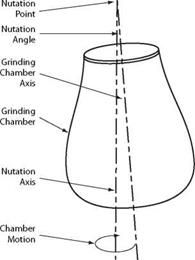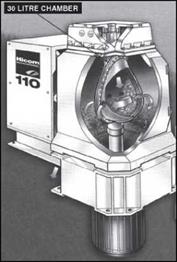One method of keeping balls in motion so that they will collide and break particles trapped between them is vibration, and a vibrating ball mill was developed and patented in Germany in the 1930s. Vibrating ball mills are either vertical or horizontal and can be used as continuous flow or batch mills, and as individual units or in series. They are driven by mechanisms similar to those used for vibrating screens.
The grinding media in vibrating mills, which occupies about 80% of the working volume, can be steel balls, silica pebbles, or alumina porcelain pebbles. The grinding media move in a radial pattern, the distance of the movement being dependent on the throw of the mechanism. The speed of the vibrating mechanism is 1,200-1,800 rpm. At the end of World War II, Allis-Chalmers obtained some of the vibrating ball mill patents and found that the best applications for vibrating ball mill were for -5- to -10-pm products.
Vibrating ball mills are less expensive to install than tumbling ball mills drawing the same power and are smaller in size and weigh less. Essentially stationary units in that
|
Motor
FIGURE 8.8 IsaMill, a horizontal disk mill used to grind fine-grained mineral ores (MIM Process Technologies 2002; reprinted by permission) |
|
TABLE 8.2 Power intensity of tumbling and stirred ball mills
Source: MIM Process Technologies 2002. |
they do not rotate, the mills do not need to be mounted in trunnion bearings. This eliminates the need for the massive foundations required by ball mills. The limited availability of large antifriction roller bearings for the vibrating mechanisms restricts the sizes of vibrating mills.
By 1970, mines near Johannesburg had reached a depth of 3,000 m, and consideration was given to underground milling to concentrate the gold minerals and to reduce the expense of transporting ore and tailings. This required mills that were much smaller than those currently in use, so the idea of centrifugal mills that would have higher breakage rates than tumbling mills was investigated. The concept had been proposed many years previously (Lloyd et al. 1982) but was not pursued on a large scale until the South African Chamber of Mines Research Organisation built and tested several centrifugal mills during the 1970s. Eventually, a 1-MW production mill, which was basically a horizontal grinding tube (1.0 m x 1.2 m) that gyrated at high speed in a vertical plane, was installed at the Western Deep Levels Mine near Carleton, Transvaal.
Philip Lloyd, leader of the research group, discussed the mill’s performance:
The mill was held between two crankshafts with a throw of about 40% of the mill’s diameter. …Operated autogenously in open circuit at 230 rpm and fed with -100 mm quartzite, it ground 26 tph to 50% -75 micron at a power draw of 480 kW. Using 32-mm steel balls in closed circuit it ground 35 tph of -19 mm feed to 67% -75 micron at a power draw of 840 kW. Development was halted when it was found the circulating load could not be increased sufficiently. The throughput was limited at the discharge—the feed arrangements worked well and had a capacity
 |
 |
of over 400 tph but although many discharge arrangements were tested we never managed to exceed a discharge much above 50 tph. Linings were simple and relining took place offline. The worn mill tube was lifted out of the cradle between the two cranks and a relined tube dropped in, a process that took about 15 minutes.
(Lloyd 2001)

